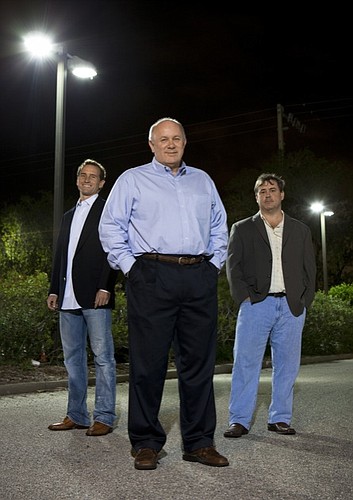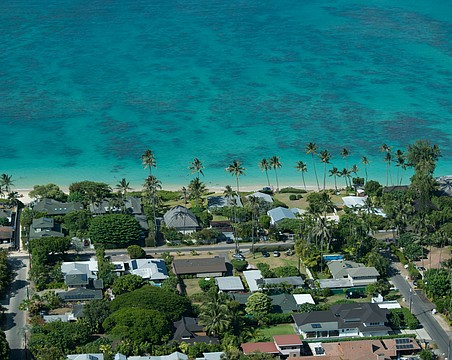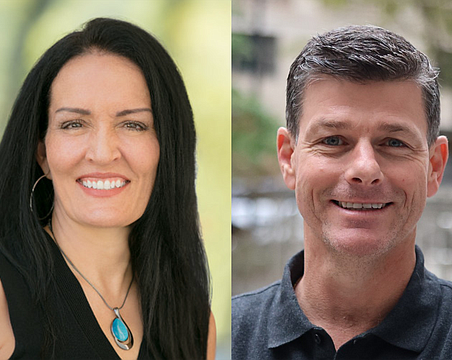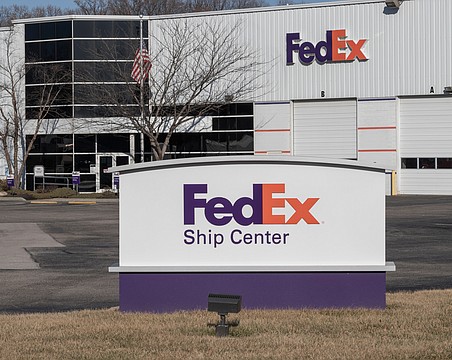REVIEW SUMMARY
Businesses. Sunovia Energy Technologies, Inc., Sarasota
Industry. Solar power, lighting
Key. Company hopes that 2010 will be a breakout year for both revenue growth and for curtailing losses.
Ron Smythe ran Meineke Car Care, billion-dollar nationwide car repair business for 20 years. So the concept of throwing good money after questionable money is likely nothing new to him.
Only now, Smythe is on the throwing side of the investment risk, not the receiving end.
In fact, Smythe's investment in Sarasota-based Sunovia Energy Technologies has the potential to be his muffler moment — something that could either be one of his greatest stock market triumphs or a colossal failure. It's a seven-figure risk also being undertaken by a handful of other Gulf Coast investors.
Over the last two years, Smythe, a Longboat Key resident, has invested about $1.8 million into Sunovia, a light and solar power technology firm. That includes a $500,000 stock purchase Smythe made as recently as mid-November.
Smythe's payoff for the 22 million shares he holds in Sunovia has so far been a combination of potential and losses, with a heavy emphasis on the latter. Sunovia has lost nearly $50 million in the last two years, for starters, a bloodletting its executives attribute to the natural course of being a relatively young business in an undefined industry.
Meanwhile, Sunovia's shares, traded over the counter, have traded for 10 cents a share or less for most of 2009. Shares were worth barely more than a nickel each for most of the summer.
Smythe, however, remains undaunted regarding Sunovia's potential success.
That also holds true for a small and eclectic group of Gulf Coast and nationwide investors that have pumped bout $20 million into Sunovia over the past two years. It's a collection of investors that includes several other retired Fortune 500 CEOs, as well as a former governor of North Carolina. It's also a group used to calling shots that, on an individual basis, will regularly ring up company executives to offer advice or talk shop.
“I know a lot of people who have invested a lot of money in this company and we haven't lost our enthusiasm yet,” says Smythe. “We are still waiting for our payday.”
Big losses
Sunovia's potential begins with the fact that it assembles and sells products in a pair of trendy businesses: Solar power and light emitting diodes (LEDs). The light emitting diodes unit, which is powered by Sunovia's proprietary technology, is run entirely by the company and its 15 Sarasota-based employees. The solar unit is a 50-50 partnership with Bolingbrook, Ill.-based EPIR Technologies.
More potential lies in the firm's pair of national political figures that serve as advisory board members. One is Spencer Abraham, the U.S. Energy Secretary in President George W. Bush's first term, while the other is Ken Juster, who served as U.S. Undersecretary of Commerce from 2001 to 2005. Juster oversaw the federal Bureau of Industry and Security.
Those contacts are key, Sunovia investment relations executive Craig Hall says, in that the duo is the company's conduit to tap into the lucrative world of government subsidies, grants and programs.
Hall concedes that solar power, for all its potential and popularity in relation to the “green” construction movement, is still almost entirely a government-funded industry.
Adds Hall: “Being a high-tech company in a very competitive world, we need to rely upon government funding.”
When it comes to the solar side of the business, Sunovia relies on EPIR Technologies. That company was founded in 1998 by Siva Sivananthan, the director of the Microphysics Laboratory at the University of Illinois at Chicago.
Utilizing a string of government funding, EPIR has been able to develop solar-based products used mostly in the defense industry, such as infrared imaging technology and biosensors. The next step, Hall says, is to expand the product line by achieving what the industry calls Grid Parity — the point at which solar energy costs the same or less than conventional grid power.
Hall projects that solar 2.0 moment could happen for Sunovia within the next two years.
Still, Sunovia isn't only about government subsidies and significant losses.
To the contrary, the company's dual divisions and its partners recently signed some contracts with a variety of customers that includes Sarasota County; a rural city outside Dallas; the U.S. Marines; and the government of the Dominican Republic. The deal with the Dominicans revolves around Sunovia supplying the government with technology assistance for the country's first solar energy plant, a $200 million project.
Deals such as those pushed company revenues up 1,566% in 2009, from $60,000 in fiscal 2008 to $1 million this year. Even better, says Hall, is the company's 2009 fourth quarter revenue growth, posted in late December, was one of its best ever on a quarter-over-quarter basis.
But the losses on the company's balance sheet and income statement stick out like a 100-watt bulb in an underground tunnel. It lost $14.47 million in fiscal 2009, for example, a mere pittance compared to the $34.92 million loss it posted in fiscal 2008. It lost money in 2007, too, when it was just getting started.
“[The losses] come with the territory when you are building a technology company in a huge area,” says Hall. “I think we have been very smart in how we have leveraged our money.”
Old friends
The company has minimized its overhead the past two years. And Hall says the company has spent its investment capital “judiciously,” as opposed to raising money in order to spend it haphazardly on a new technology project.
Hall also predicts that the multimillion-dollar annual loss machine will grind to halt soon. For example, Hall predicts Sunovia's LED unit will turn a profit by the end 2010. The solar power division, however, will likely continue losing money through 2012, says Hall.
The company's dual focus of marketing and selling LEDs and solar power products, says Hall, is one of its defining characteristics. It's also one of the key reasons the company has been able to attract its All-Star list of investors. “Most companies usually do one or the other,” says Hall. “But we always wanted to be able to do both.”
Technically, that theory goes back to when the company was founded in 2006. But the genesis of the business can be traced back as far as 2000, when Hall, who then ran the bond-trading desk at RBC Centura Bank in North Carolina, received a call from Carl Smith.
Smith and Hall had been friends since the third grade, when they both grew up in the mountains of western North Carolina. Smith had since relocated to Sarasota, where he was a principal in Research Capital Partners, a family-run venture capital firm that focused on investing in early-stage biotechnology companies.
Smith wanted to know if Hall would help him research and vet companies, such as one entity that was trying to build solar-powered cell phone rechargers.
Another company that Research Capital invested in was DNA Print Genomics, a publicly traded Sarasota-based pharmaceutical and genetics company that, like Sunovia, lost millions of dollars in its startup phase a few years ago. Former DNA Print Genomics executive Tony Furdakis now works for Sunovia.
Smith and Hall, however, stuck mostly with the solar power technology, believing that the field was on the cusp of a breakthrough. Smith, Hall and Rick St. George, a Sarasota entrepreneur and investor, co-founded Sunovia in 2006 and 2007 after a series of small acquisitions and a reverse merger.
The LED side of the business was the brainchild of Bob Fugerer, an electrical engineer who joined the company soon after it was founded. Fugerer, now president and chief technology officer of Sunovia, previously worked for Arrow Electronics in Tampa.
Cobra collection
Under Fugerer's guidance, Sunovia runs its LED unit from the company's 6,000-square-foot facility in a Sarasota industrial park. That's where it researches, assembles and sells the lights and related products, all under the EvoLucia brand name. LED light bulbs, which have been available on the consumer market for a few years, use up to 75% less energy than traditional light bulbs. The technology has been used in appliance and watch making for more than 40 years.
Sunovia engineers, however, have discovered a way to harness traditional LED technology for a wider array of uses. That proprietary technology fostered the development of the company's first two major LED products earlier this year: Cobra head streetlights and a cobra head retrofit kit.
The cobra head streetlight is one of the most popular styles of street light posts in the country. But Sunovia executives say the majority of those lights use high-pressure sodium or metal halide technology, which is both expensive and environmentally unfriendly. “We believe our LED technology will represent a technological breakthrough resulting in energy and cost savings in comparison to products currently available on the market,” Sunovia executives tout in a recent Securities and Exchange Commission filing.
Sunovia recently basked in two separate successful sales efforts regarding its cobra LED products. One, in October, was a deal to install 1,100 EvoLucia cobra head lights on roads in Camp Lejeune, N.C., home of the largest U.S. Marine base on the east coast. The lights, which Sunovia executives claim can run during the nighttime for up to 12 years without replacements, were mounted on existing light poles.
A second deal was for Sunovia to provide 150 EvoLucia lights for Sarasota County, which intends to install the lights along poles on Fruitville Road. The company says the project will ultimately save the county $14,000 a year in energy and maintenance costs.
Still, Hall admits that in many cases, municipalities and businesses will pay more, at least in the short-term, for LED products than for traditional light bulbs. At least until the technology catches up with the market.
“Like any early stage technology company, it's more expensive right now,” Hall says. “But you can get a savings in two to three years.”
HELP WANTED
Sarasota-based Sunovia Energy Technologies plans to launch 2010 with a move practically unheard of on the recession-laden Gulf Coast: It's growing.
The light and solar power technology firm, with 15 employees, plans to hire at least 10 people in the first quarter of next year, says Craig Hall, an investor relations executive with the company. The positions will be in administration, sales and engineering.
The company might also expand its physical presence in 2010 as well. It currently operates out of a 6,000-square-foot facility in a Sarasota industrial park. Hall says about 5,000 more square feet are available directly next door, as the local division of a nationwide security firm shutdown that office in the 2008.
AT A GLANCE
Sunovia Energy Technologies
Headquarters: Sarasota
CEO: Carl Smith III
FY 2009 Revenues: $1 million
Stock symbol: SUNV
Recent stock price: $.11
52-week stock-price range: $.03 - $.30
Price-earnings ratio (trailing 12 months): N/A
Dividend: N/A
Market capitalization: $72.78 million
Source: Yahoo! Finance, Google Finance
To Sunovia Energy Technologies by the numbers, download here. SunoviaBytheNumbers.pdf
Mark Gordon covers the Sarasota-Manatee region. He can be reached at [email protected], or 941-362-4848.






